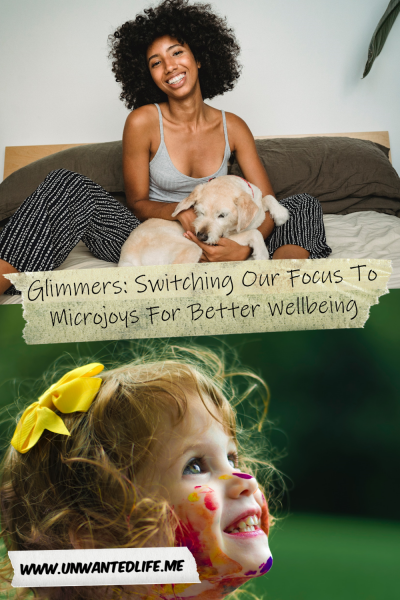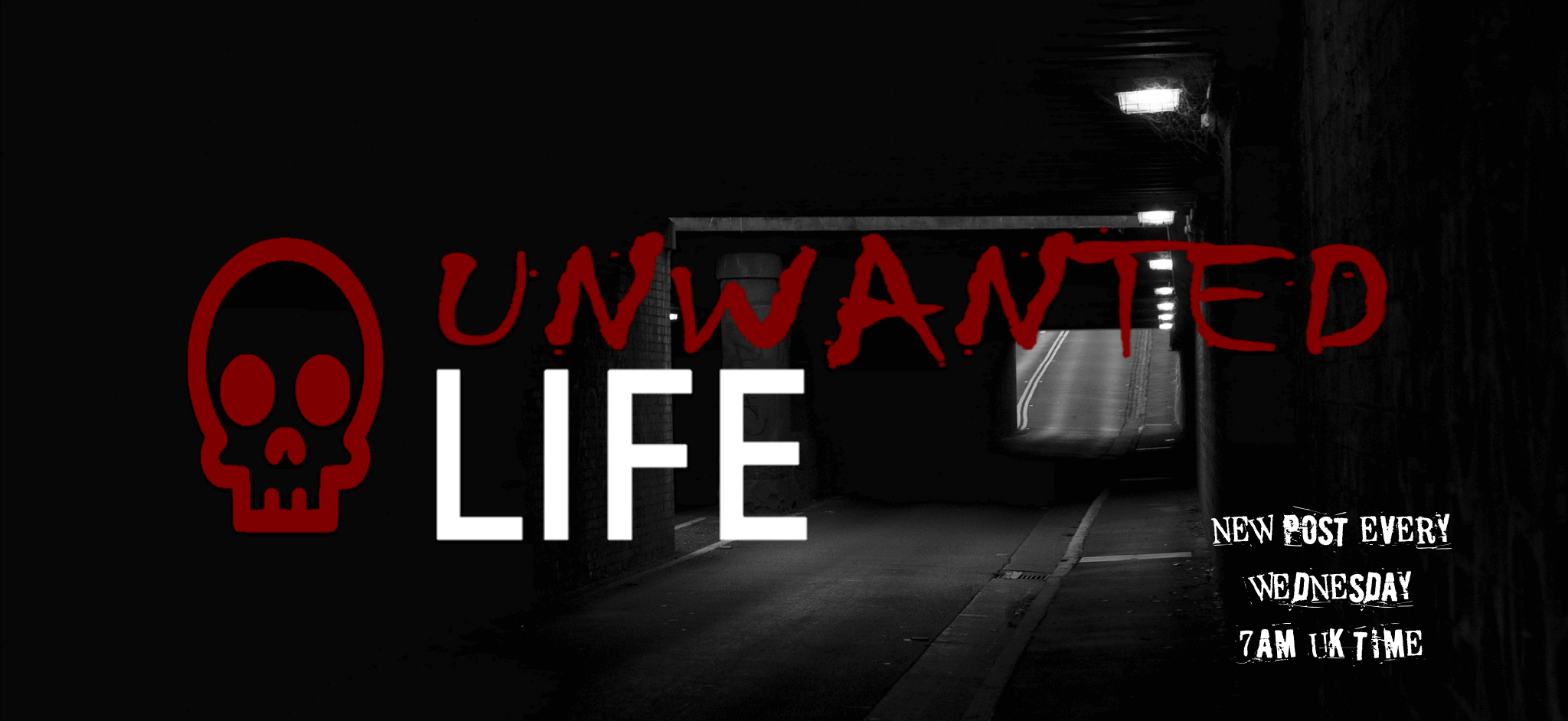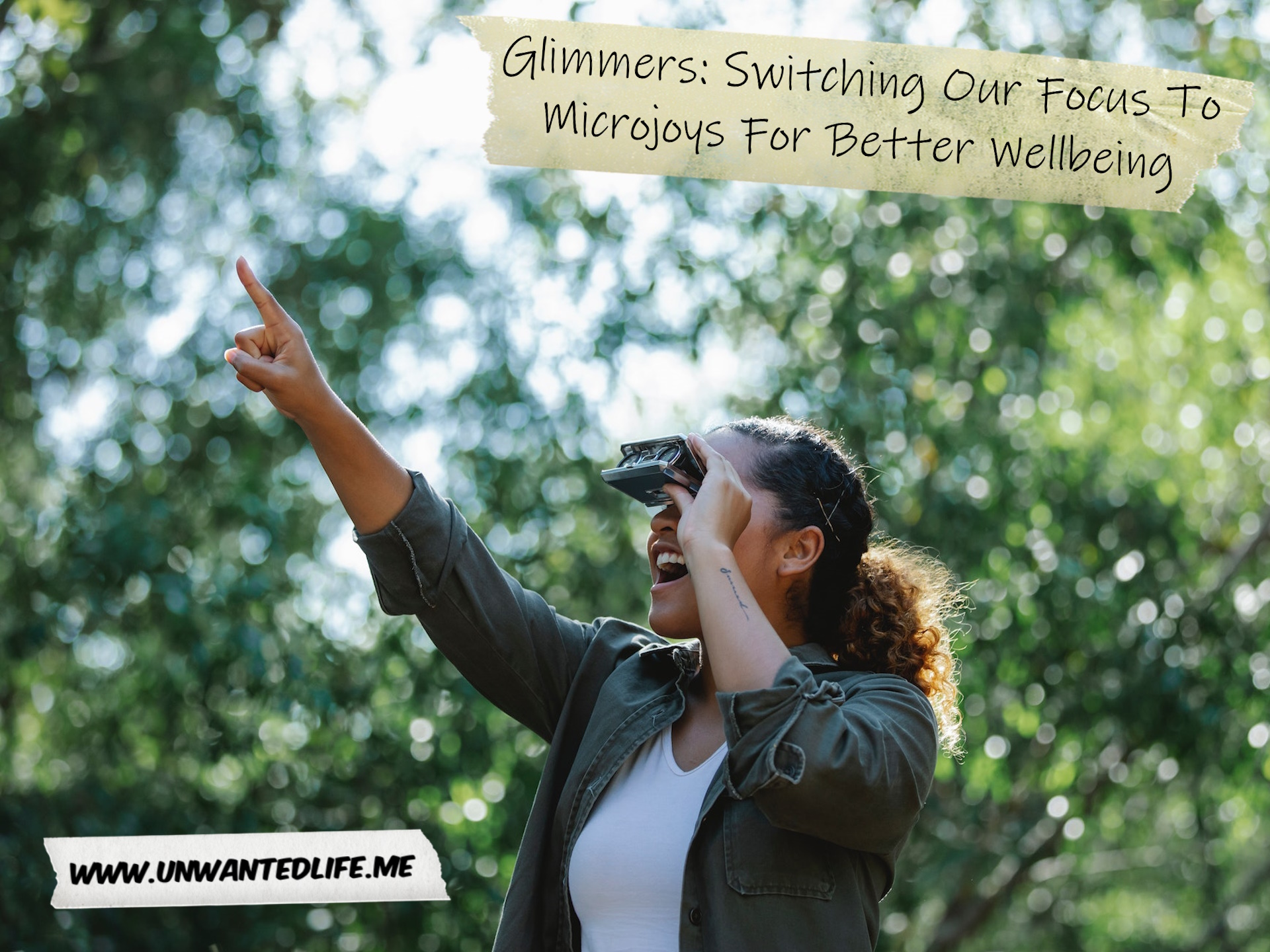I stumbled across glimmers by chance but found the concept really interesting, so I decided to write an article about it. So I hope you enjoy finding out what glimmers are and how your wellbeing could benefit from them.
What Are Glimmers?
When it comes to the big moments in our lives where we experience joy, such as achievements like graduating from university or acing your job interview, it’s easy to acknowledge those moments. But those big moments don’t happen that often. As such, for the sake of our happiness and overall wellbeing, we can’t depend on these big moments for our sense of joy and overall happiness (Stylist).
Have you ever been told something so funny that you lost the ability to breathe because you were laughing so much? Now that’s a real moment of pure joy, just in a microjoy format. It’s these that really affect how happy we are in life, rather than the big moments that don’t happen all that often. Think about it, you can be having a terrible day, but then someone says something so funny that you can’t help laughing, and just like that, your day isn’t as terrible as it was.
Glimmers are these small moments of joy but are also small moments of feeling calm, quiet, relaxed, and comfortable (Stylist). According to psychotherapist and trauma therapist Lauren Baird, when speaking to Hello!, recognising these small moments, these glimmers, can help us nurture our nervous systems and improve our mood.
How Can Glimmers Be Useful?
Triggers
The argument for glimmers is that they’re the opposite of triggers. When it comes to mental health, a trigger is something that causes a strong negative emotional reaction in response to something, such as a situation, a sound, etc. (Verywell Mind). Glimmers, on the other hand, are said to cause the opposite reaction.
For example, if you have post-traumatic stress disorder (PTSD) after being involved in a car crash, then maybe the sound of a car could trigger an anxiety response. Well, with glimmers, you may see something that triggers a positive reaction, like a feeling of joy when you hear the voice of someone you find comforting or seeing something beautiful, like a rainbow (Choosing Therapy).
In short, there’s an argument for glimmers being cues we can use to change our moods for the better, in much the same way you can train yourself to relax using a cue by embracing cue-controlled relaxation.
This is meant to be because our brains are wired to scan for dangerous and potential threats, but what we seem to be less aware of is how our brains also scan for signs of safety (Therapy With Abby). This is one of the reasons why being someone who is considered a safe space can be so important.
Identifying our triggers is relativity easy because of the fight-or-flight response they often cause us to feel. But just like it can be important to identify our triggers to help us overcome them, it can be just as useful to identify our glimmers. Once you’ve identified what your glimmers are, then you can use these to help manage your moods.
Examples of glimmers
- Patting an animal.
- Feeling the warmth of the sun on your skin.
- Hearing laughter.
- Praying.
- Giving or receiving a hug.
- Singing along to a song.
- Dancing.
- Engaging in a hobby.
- Chatting to a friend.
- Hearing a certain song.
- Taking in a deep breath.
Mindfulness and positive psychology
While using glimmers as a form of cue control to change our moods has its uses, there’s also the argument that can be made for its mindfulness and positive psychology applications. By focusing on these microjoys, you training yourself to focus on the positives in your life, no matter how small. Given how easy it is for us to develop a thinking error that causes us to focus on the negatives, this is certainly something useful for us to develop.
Furthermore, by focusing on these glimmers, we’re also helping ourselves to live in the present, which is a cornerstone of mindfulness. One way to help you appreciate these microjoy glimmers could be to make a note of them in a journal, like a positivity journal. Simple, but effective.
Believe it or not, one of the most joyful moments in my life came when my friend said one thing to me, which I found so funny I couldn’t breathe, and I’ve never forgotten that. And it can still bring me a little joy to remember that, as well as when I recount it to someone else.
This can be the power of microjoy glimmers. It’s also these small glimmers that can actually cause us to feel happier in our lives, rather than the big moment we often get fixated on.

Tips For Focusing On Microjoy Glimmers
They may be microjoys, but these glimmers have a bigger effect than we give them credit for. So the following are tips on how to focus on your microjoy glimmers.
Notice sensory details
Savour pleasant sounds, smells, textures, tastes, and sights you experience in life, just as mindfulness would have us do. Appreciate the feeling of a warm drink, a dog’s soft fur, and the crunch of leaves underfoot.
Capture moments
Now, I’ve never been one to take photos, and sometimes doing so can get in the way of living in the moment. But, when used correctly, photograph your happy moments as they happen so you can connect with that memory more easily and appreciate the feelings. Or you could try mentally freezing and fully taking in the moment.
Share the joy
Point out and discuss little peak moments you notice others experiencing to spread the microjoy glimmers.
Smile and laugh
Even forced smiling releases feel-good neurotransmitters, but better than that, look for humour and laugh often.
Mindfully enjoy activities
Eat slowly, tune into your senses, and immerse yourself in hobbies to draw out your feelings of joy and happiness.
Express gratitude
This is a classic positive psychology intervention, for a reason. Appreciate little blessings verbally or through a gratitude journal. Thank people often. A study by O’Connell, O’Shea, and Gallagher (2017) supports the benefits of having a gratitude journal, finding that it lowers depressive symptoms.
Relish small accomplishments
Recognise daily progress and mini-wins, whether their work tasks, household chores, or completing something on your to-do list.
Use cue reminders
Use post-it notes to remind yourself to notice microjoys throughout your day, just because, such as a reminder to smell the flowers. But you can also use your glimmer list to work as cues to help get you out of a bad mood.
Act purposefully
Align small actions with your values to give daily tasks more meaning and fulfilment. If we can live with meaning, then we are more likely to feel happy and content with our lives.
Slow down
Ditching the daily hustle for something more relaxed, as illustrated by those trying out bed rotting, escapes the urgency of the daily hustle and tuning into the present will help reveal fleeting joys.
Summary
Microjoy glimmers might just be the secret to happiness, which would make focusing on these small moments of joy and calm in our lives an act of self-care. As far as I can see, we can continue to miss the importance of the glimmers in our lives or we can embrace them and improve the chances of our lives being better as a result.
So which will it be? Will you continue to ignore your glimmers or will you embrace them? And if you will embrace them, then what will you do to embrace the microjoy glimmers and glimmer cues in your life?
As always, leave your feedback in the comments section below. Also, please share your experiences with glimmers in the comments section below as well. Don’t forget, if you want to stay up-to-date with my blog, then sign up for my newsletter below. Alternatively, get push notifications for new articles by clicking the red bell icon in the bottom right corner.
Lastly, if you’d like to support my blog, you can make a donation of any size below. Until next time, Unwanted Life readers.
References
O’Connell, B. H., O’Shea, D., & Gallagher, S. (2017). Feeling thanks and saying thanks: A randomized controlled trial examining if and how socially oriented gratitude journals work. Journal of Clinical Psychology, 73(10), 1280-1300. Retrieved from https://mural.maynoothuniversity.ie/11705/1/OConnell_Feeling.pdf and https://onlinelibrary.wiley.com/doi/abs/10.1002/jclp.22469.


This is interesting, first time to know about this and how it can help with wellbeing. Very informative!
Thanks for commenting
The concept of glimmers is new to me, but I understand how important it is to focus on small moments of joy in our daily lives. A glimmer for me is breathing in salty beach air. I’m instantly calm and my mood improves. Great article.
I’m glad you’ve already found a glimmer that works for you. Thanks for sharing
Great post. 🙂
Thanks
Thank you for this great article. It’s made me think about the importance of stopping, thinking & turning the day around!
Most days can be saved if you can find a small moment of joy, some form of positivity, or a silver lining. Thanks for commenting
The idea of shifting focus to micro joys is really insightful and beautifully articulated. It really got me thinking. Keep up the fantastic work!
Thank you
Such great tips for noticing and enjoying the small moments in your day. It’s important to do this!
Indeed it is
I like this and not heard of this before. I have already had one Glimmer this morning while reading some funny memes in a blog post. One of them really cracked me up.
So with that and knowing what Glimners mean, I know my Glimmers are.
Thank you for this post.
Laughter is the best medicine after all. Thanks for sharing
Yes. Laughter is the best medicine.